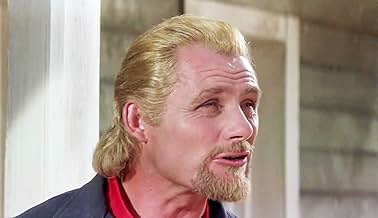NOTE IMDb
5,8/10
1,7 k
MA NOTE
Ajouter une intrigue dans votre langueGeorge Armstrong Custer's love of the heroic traditions of the Calvary and his distaste with the coming of industrialization leads him to his destiny at the Little Big Horn.George Armstrong Custer's love of the heroic traditions of the Calvary and his distaste with the coming of industrialization leads him to his destiny at the Little Big Horn.George Armstrong Custer's love of the heroic traditions of the Calvary and his distaste with the coming of industrialization leads him to his destiny at the Little Big Horn.
Charles Stalmaker
- Lt. Howells
- (as Charles Stalnaker)
Histoire
Le saviez-vous
- AnecdotesOriginally to be directed by Akira Kurosawa, but he pulled out.
- GaffesThe troops of the 7th Cavalry are shown with 1873 Winchester rifles, which were in wide use by 1876, but not by the US Army. Custer's men were armed, as all troopers who did not purchase their own rifles were, with the 1873 Springfield Trapdoor carbine, a single-shot weapon. Had Custer's men been armed with the Winchester, it is possible, though unlikely, that they could have held out until relieved.
- Citations
Gen. Philip Sheridan: You know, you could become a living legend... or get yourself killed. Dead men make better legends.
- Versions alternatives35mm prints released in both complete and shortened versions. Some shortened versions were titled "A Good Day for Fighting".
- ConnexionsFeatured in I Am Not Your Negro (2016)
Commentaire à la une
An unusual cast was gathered for this tribute to a western hero whose accomplishments in real life are dubious to say the least. Scholars and history buffs can argue the facts and merits of General George Armstrong Custer. This review pertains to the actual film. It begins with a very odd credits sequence in which Shaw and Ure are billed as starring, then the title comes up and then zilch. No other actors or crew are mentioned. Then four years of Civil War battles are represented by years popping up on screen as Shaw tears across what looks like the same field on horseback while cannons blast continuously. So much for establishing his war record...from this he basically outran some cannons for four years straight! He gets new orders from superior Tierney (brandishing a very contemporary accent that's just as jarring as Shaw's own British-tinged one) and is soon headed out west to rid the land of Indians. First, he is reunited with his wife (in real life as well) Ure in a series of brief, strange vignettes as they travel to his new post. Once there, he is greeted by a haggard-looking Hunter (who would be dead in real life within a year) and fit, yummy Hardin (miscast as a drunkard.) In fact, the film ties with "Ride the Wild Surf" as having the most cast members change their usual looks for their roles. Brown-haired Shaw goes blonde, blonde Ure goes auburn, Hunter's hair is longer and bushy with fake gray highlights and Hardin's blonde locks are brown and he sports a huge moustache. Ryan, as a soldier who deserts to find gold, pops in long enough to show up everyone else and display what good acting can be. The film details Shaw's struggle to solve the "Indian problem". The government wants rid of them, yet he sees, to an extent, their plight. Unfortunately, the film is so episodic and disjointed in it's scripting that it can't build very much momentum or create a memorable story. Though it is long, the audience never really gets to know the characters very well. A lot of time is spent on rather elaborate set pieces (some of which are impressive) like a wagon wreck, a ride down a log flume, an attack on a train and the final stand off. Another chunk of time is wasted in ludicrous Washington scenes which include a cheaply done speech by Shaw before Congress and a (deliberately?) horrible stage show. (Shaw wrote the lyrics of one of the songs himself!) One of the best sequences involves Shaw's attempt to show his men who is boss through a rigorous training exercise in which all but one fall down completely. One major asset is the wide-screen photography which shows off some nice scenery and a few inventive compositions. The finale, with its horde of Indian warriors, is surely best seen in the letterboxed format. It's surprising to see such an old fashioned us (Cavalry) vs them (Indians) approach in a 1968 film, four years after "Cheyenne Autumn". Aspirations to tell a complex version of the tale are done in by sketchy characterizations and poor performances by some of the supporting cast (including Moore as the primary Indian chief.) The score is distracting and often overly loud. The acting is uneven. The editing is profanely awkward. In the end, the audience has not been enlightened to any degree and has watched a two hour and twenty minute film in which Hardin didn't even take his shirt off once!
- Poseidon-3
- 11 mars 2003
- Permalien
Meilleurs choix
Connectez-vous pour évaluer et suivre la liste de favoris afin de recevoir des recommandations personnalisées
- How long is Custer of the West?Alimenté par Alexa
Détails
- Date de sortie
- Pays d’origine
- Langue
- Aussi connu sous le nom de
- A Good Day for Fighting
- Lieux de tournage
- Sociétés de production
- Voir plus de crédits d'entreprise sur IMDbPro
Box-office
- Budget
- 4 000 000 $US (estimé)
- Durée2 heures 20 minutes
Contribuer à cette page
Suggérer une modification ou ajouter du contenu manquant

Lacune principale
By what name was Custer, homme de l'Ouest (1967) officially released in India in English?
Répondre





























